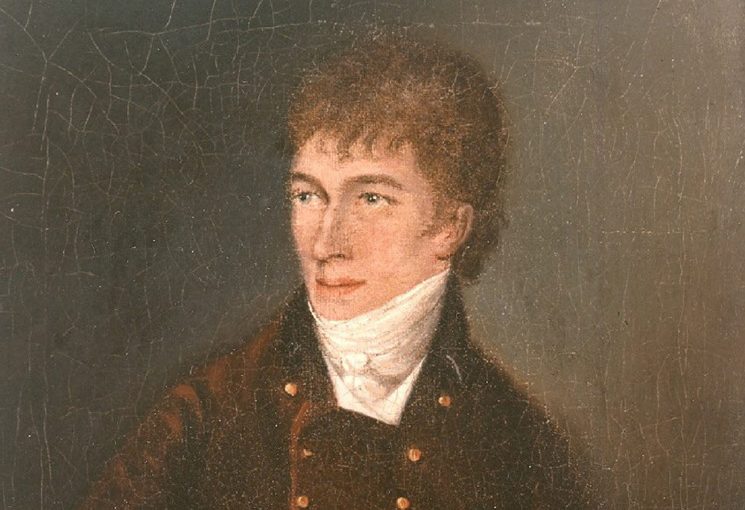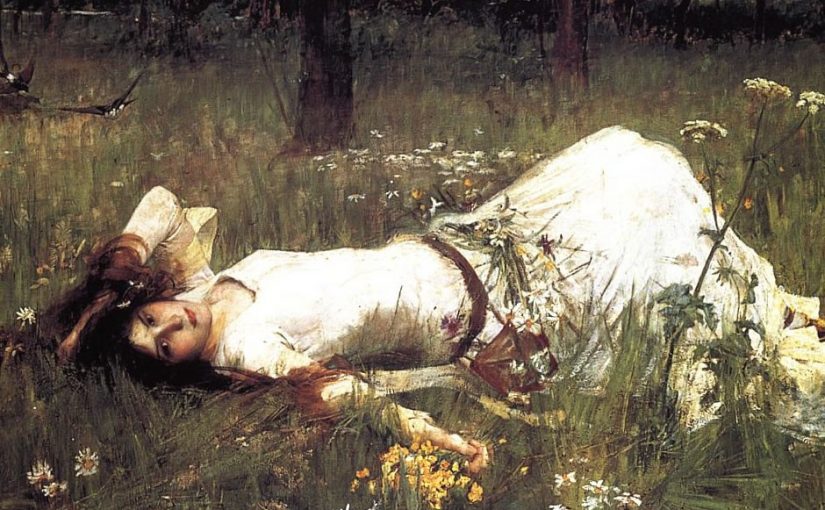81 mil tur och retur till Lidköping. Men det var det värt! 78 personer kom och lyssnade – nytt rekord! Bokförsäljningen gick också bra. Och vilket fint bibliotek och vilket perfekt arrangemang!
Kategori: Om Systrarna Brontë
Patrick Brontës födelsedag!
Den 17 mars 1777 föddes Patrick Brontë, systrarna Brontës far, i Drumballyroney, County Down på Irland. Hans efternamn namn skrevs då omväxlande som ”Brunty”, ”Prunty” och ”Bruntee”. När han började i Cambridge bytte han namn från Brunty till det mer originella och imponerande Brontë. Kanske ville han ta efter sin hjälte Nelson, som 1799 blivit hertig av Brontë. Brontë är också det grekiska ordet för åska. Han använde olika accenter ovanför ”e” i sitt efternamn men när han började ge ut samlingar med poesi och prosa använde tryckeriet trema och det var den accenten som hans barn lade sig till med.
Så här sa han på sin ålders höst:
Hade jag räknats till världens lugna, stillsamma, sansade män skulle jag inte ha blivit som jag nu är och jag skulle sannolikt aldrig ha fått sådana barn som mina har varit.
Charlotte Brontë nobbar en friare
Så här skrev Charlotte till väninnan Ellen Nussey för precis 187 år sedan:” On the matter of Henry Nussey’s proposal, 12 March 1839: ’Now my dear Ellen there were in this proposal some things that might have proved a strong temptation – I thought if I were to marry so, Ellen could live with me and how happy I should be. but again I asked myself two questions – Do I love Henry Nussey as much as a woman ought to love the man her husband? Am I the person best qualified to make him happy? – Alas Ellen my Conscience answered ’no’ to both these questions. I felt that though I esteemed Henry – though I had a kindly leaning towards him because he is an amiable – well-disposed man yet I had not, and never could have that intense attachment which would make me willing to die for him – and if ever I marry it must be in that light of adoration that I will regard my Husband ten to one I shall never have the chance again but n’importe. Moreover I was aware that Henry knew so little of me he could hardly be conscious to whom he was writing – why it would startle him to see me in my natural home-character he would think I was a wild, romantic enthusiast indeed – I could not sit all day long making a grave face before my husband – I would laugh and satirize and say whatever came into my head first – and if he were a clever man & loved me the whole world weighed in the balance against his smallest wish should be as light as air – ’
RadioTimes: To Walk Invisible – Who were the real Brontë sisters?

”Later, I came to the books; I think I’ve read all of them now, but it was reading Wuthering Heights when I was about 14, possibly earlier, that really pulled me in. I was blown away by how it’s so unlike anything you think women would be writing at that time. It’s so down-to-earth, it talks about the coarseness of real life, and that’s something that appeals enormously to me as a writer.”
Read on to find out more from Wainwright about the Brontës, how they lived and what she thinks they were really like – as well as a little extra historical context.
Starting with…
General life for the Brontës

”I’ve now done a lot of research into how the Brontës lived,” Wainwright says. ”Life expectancy in [Yorkshire town] Haworth at that time was 19, mainly due to poor sanitation – the main street would have been running with sewage.
”It was a bleak place to grow up, but it was close to Halifax, which had concerts and a thriving Philosophical Society and a Literary Society, so in many ways life for the Brontës was more sophisticated than we realise.”
How they spoke

”Writing a period drama is very different from writing contemporary drama and it’s often harder, because you’ve got to respect that people spoke in certain ways,” Wainwright says.
”I recently watched the 1970s drama serial about the Brontës, and they all spoke extremely correctly, posh and stiff, as if they’d been to drama school. Certainly they would have known correct grammar, but they would most definitely have had a Yorkshire accent and used local phrases.
”We’ve got books that have dialect in them, but we don’t know how accurate they are, so I’ve had to be quite inventive with the use of language, because I desperately wanted to get away from making it sound like just another period piece.”
The life of Charlotte (1816-55)

Finn Atkins as Charlotte Brontë in To Walk Invisible
”Charlotte (author of Jane Eyre, Shirley and Villette) was ambitious and very pushy; she clearly wanted to put herself out there,” Wainwright says.
”She lived for seven years after Anne died, she got married and was immensely celebrated in her own life-time, almost like she was a rock star.
”So she had a very different life, in the end, to the life Anne and Emily had. I’ve dramatised the sisters as being quite antagonistic to each other – there’s a scene where Emily slaps Charlotte and pushes her around, which may surprise some – but I think it comes across, subtextually, in what we know about Emily and Charlotte that they had quite a difficult relationship.”
To Walk Invisible picks up Charlotte after her return from a school in Brussels, where she and Emily had travelled to learn and teach English and music respectively until their Aunt Elizabeth Branwell (played by Jill Baker in flashbacks) died, calling them back to England. In 1843 Charlotte went back to Brussells alone, having become deeply attached to the married man who ran the school, Constantin Héger. However her second stay was not a happy one, and she returned to Haworth in 1844, later using her time in Brussels as inspiration for parts of The Professor and Villette.
After the events of To Walk Invisible (which sees her and her sisters’ books published), Charlotte outlived all her siblings and was the only Brontë to really enjoy public approval for her work. After marrying her father’s curate Arthur Bell Nicholls (played by Rory Fleck Byrne in the drama) in 1854 Charlotte fell pregnant, but died the next year before the child was born due to complications (probably extreme dehydration caused by vomiting and morning sickness, though some think she may have caught Typhus).
The life of Emily (1818-48)

Chloe Pirrie as Emily Brontë in To Walk Invisible
”Emily was intensely private, and resented any attempt to push her around,” Wainwright says. ”You’ve got to remember that Emily is the person who wrote Wuthering Heights; she went walking on the moors every day, and I wanted her to come across as vibrant and robust, not some pretty little miss out of Jane Austen.”
Of the three sisters, Emily struggled the most to find work teaching (the others were teachers or governesses at various points), telling one class that she preferred the dogs she’d met to any of the pupils. In the end after leaving a couple of positions she became more of a stay-at-home daughter, doing most of the cooking, cleaning and ironing for the family at the Parsonage while her sisters went out to work.
Emily caught a cold shortly after her brother Branwell’s death, which developed into an inflammation of the lungs and tuberculosis, leading to her death in 1848 after refusing to see ”poisoning doctors”.
The life of Anne (1820-49)

Charlie Murphy as Anne Brontë in To Walk Invisible
”I think Anne (Agnes Grey, The Tenant of Wildfell Hall) was the one who calmed her sisters down and made the relationship workable,” says Wainwright.
”She’s often dramatised as just being there to make up the numbers, but the quality of her work was just as astonishing as her sisters’ and I wanted that strong personality to come across.”
Anne left Haworth to work as a governess from 1839, mostly for the Robinson family at Thorp Green, and secured a job as tutor for her brother Branwell there in 1843. She left in 1846 shortly before Branwell was fired, probably after learning of his affair with the wife of their employer. She made lifelong friends with the Robinson children, however, and as a teacher was the only one of the Brontës who can be said to have found real success with the profession.
After returning home Anne, with her sisters, published a book of poems under the pseudonyms of Currer, Ellis and Acton Bell, paid for by money left to them by their late Aunt Branwell. Unfortunately, despite favourable reviews, the book only sold two copies, though it was enough to spur Anne and her sisters to write and publish the novels that would truly make their names.
After the publication of Agnes Grey and The Tenant of Wildfell Hall in 1847 and 1848 (the latter of which became a best-selling sensation, described as shocking for its depiction of alcoholism and debauchery), the death of Emily in September of the latter year affected Anne deeply. The pair had been close as children (collaborating on stories about the fictional land of Gondal as Charlotte and Branwell did for their own made-up country of Angria), and soon Anne’s grief overwhelmed her physical health, with the youngest Brontë catching influenza and then tuberculosis. After lingering for a few months, she died in 1849.
After death, Anne’s legacy has faded the most of the Brontë sisters, which some attribute to the actions of the still-living Charlotte when she blocked the posthumous republication of The Tenant of Wildfell Hall due to her disapproval of its content.
The life of their brother…

Adam Nagaitis as Branwell Brontë in To Walk Invisible
”Branwell (1817–48) is often just written off as “the wastrel brother”, but he was very talented, too,” Wainwright says.
”As a child he was the leader in a lot of their intellectual games and in their writing, but the sisters had the absolute gift of hard work, and I don’t think Branwell did. While there’s doubt, now, that he was an opium addict, Branwell certainly suffered from alcoholism, which, of course, is an illness. Nobody chooses to be an alcoholic and I wanted to show what living with this illness does to a family.”
To find out more about Branwell and his life, read our in-depth article here.
…and their father

Jonathan Pryce as Patrick Brontë in To Walk Invisible
”Much of what we think we know about the Brontës is coloured by [Elizabeth] Gaskell’s biography of Charlotte, which was by no means objective,” Wainwright says.
”She elaborated a lot to make a good tale and certainly she portrayed Patrick Brontë (1787– 1861) as a harshly authoritarian father. Juliet Barker, whose books I used a lot to research the film, has a very different version of Patrick. I think that, being Irish, he would have known the power of storytelling, and I’ve portrayed him as an enlightened man who very much believed in empowering women intellectually.”
Brontë outlived all of his children and his wife Maria Branwell Brontë (the latter by forty years), and after Charlotte’s death co-operated with Elizabeth Gaskell’s biography of his daughter. He lived until he was 84, during which time Charlotte’s husband and his former curate Arthur Bell Nichols lived in the Parsonage with him.
Conclusions

”The BBC approached me about five years ago to do something for the bicentennial of Charlotte’s birth in 1816,” Wainwright (above with actor Jonathan Pryce) recalls in her Radio Times piece.
”They wanted a biopic, and it could have been a full series, but I wanted to focus on the Brontës as mature adults, so I chose the three-year period leading up to Branwell Brontë’s death in 1848. The tragic aspect of the Brontës – three of the siblings died within ten months of one another – has always been a draw, but in this film I really didn’t want them to be defined by their deaths.
”What fascinates me is the fact of three literary geniuses sitting in the same room, and the fact that they were all women. It’s an extraordinarily compelling story, and I hope I’ve done it justice.”
Föreläsningar om systrarna Brontë
I torsdags inledde vi vår lilla föreläsningsturné på Mariefreds fina lilla bibliotek (bilden) där supertrevliga och proffsiga bibliotekarien Stina tog väl hand om oss.
Vi pratar om systrarna, visar bilder och svarar på frågor under drygt en timme. Man kan också köpa vår översättning av Ann Dinsdales populärvetenskapliga bok Systrarna Brontës Värld direkt av oss för 150:-, 50:- billigare än hos nätbokhandlarna.
Vårt schema ser ut så här:
- 4 oktober Leksands bibliotek
- 6 oktober Gävle pensionärsuniversitet
- 13 oktober Norrtälje stadsbibliotek
- 26 oktober Flens bibliotek
- 14 november Sollefteå bibliotek
- 17 november Sandvikens bibliotek
- 24 november Sollentuna bibliotek
- 30 november Gnesta bibliotek
- 10 januari Falu Senioruniversitet
- 15 mars Knivsta bibliotek
Det kan bli ytterligare några föreläsningar under första halvåret 2017.
Kom gärna och lyssna om du finns i närheten!
Systrarna Brontë i Japan
Djupsinnig och intressant läsning:
Och så här tycker biblioteket i Karlskrona om Systrarna Brontës värld:
I år är det 200 år sedan den engelska författaren Charlotte Brontë föddes. Hon och hennes systrar Anne och Emily gav ut ett antal romaner – förvånansvärt få – varav i stort sett alla numera ses som klassiker. Med anledning av jubiléet har det kommit ut en mycket vacker och läsvärd bok om syskonen Brontë, med många bilder och unikt material. Författaren Ann Dinsdale är museichef på Brontë Parsonage Museum i Haworth, där syskonen växte upp.
Alla familjemedlemmar porträtteras i ord och bild, men vi får också lära känna miljön och landskapet där romanernas karaktärer kom till. Följ med ut på hedarna där Cathy’s osaliga ande (från ”Svindlande höjder”) för evigt irrar omkring och söker sin älskade Heathcliff, eller till herrgården som stod modell för Mr Rochesters Thornfield, där han håller sin galna fru inspärrad på vinden, och där kärlek till slut uppstår mellan honom och den unga guvernanten Jane Eyre. Drömmen vore ju att göra en resa på engelska landsbygden med Dinsdales bok som guide! En författare som gjort slag i saken och bokstavligen vandrat i systrarna Brontës fotspår, är Samantha Ellis, vilket hon beskriver i boken ”Mina hjältinnor”, läs här vad Malin skrev om den.
Charlottes mest berömda roman är ”Jane Eyre”. I en artikel i Guardian har ett antal välkända författare fått skriva om vad boken har betytt för dem. Jag har tidigare här på bloggen skrivit om ”Jane Eyre”, som förmodligen är det litterära verk jag läst flest gånger – några gånger av egen vilja, och några gånger var jag därtill nödd och tvungen! Många anser dock att ”Villette” är Charlottes bästa roman, och den kom faktiskt i svensk nyöversättning förra året, och den ska jag förstås läsa under detta jubileumsår.
/Åsa
Från Haworth till Hollywood
Ja, så blev det sannerligen för systrarna Brontë! På bilden ser man några av de som under åren spelat Jane Eyre och mr Rochester i Charlottes bok. Så här många versioner av Jane Eyre finns det – minst:
- 8 stumfilmer
- 12 ljudfilmer
- 13 tv-serier
- 2 baletter
- 2 operor
- 2 musikaler
- 2 teaterpjäser
Och fler kommer det att bli! Tala om levande klassiker!
Från Haworth till Hollywood är också titeln på ett kapitel i Systrarna Brontës värld. Köp boken så får ni veta mer om hur systrarnas skapande lever vidare!
Beas Bokhylla recenserar Systrarna Brontës värld
Laurence Olivier som Heathcliff och Merle Oberon som Cathy i 1939 års filmatisering av Wuthering Heights
… Det finns något både för den inbitna Brontë-fantasten och för den som just ska lära känna medlemmarna i Brontë-familjen …
Hela recensionen här.
Köp boken på Adlibris (187 kr), Bokus (193 kr) eller direkt från förlaget (185 kr).
Bokbloggen Hernia says har läst Systrarna Brontës värld
…. fastnar jag både i de vackra bilderna från deras närmaste miljö, av manuskript och teckningar men också i mer kuriösa detaljer …. Systrarna Brontës värld är inte en bok jag läser från pärm till pärm, och det är nog heller inte tanken, men jag kommer att fortsätta flanera runt i den. Men framförallt kommer jag att fortsätta att läsa och läsa om Brontës egna texter för det lockar också den här boken till. Hela texten här








